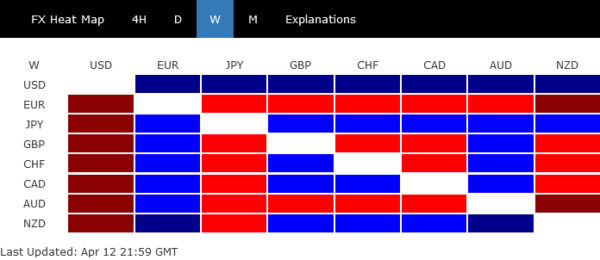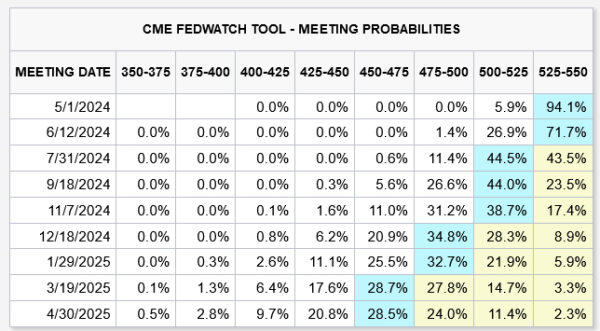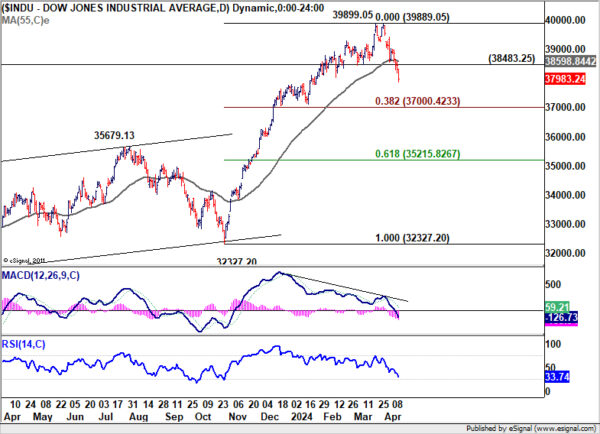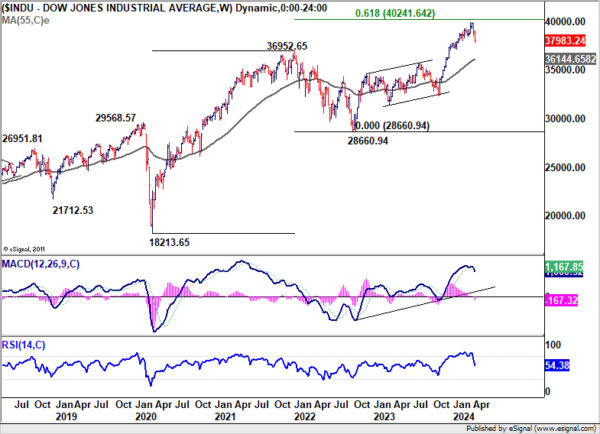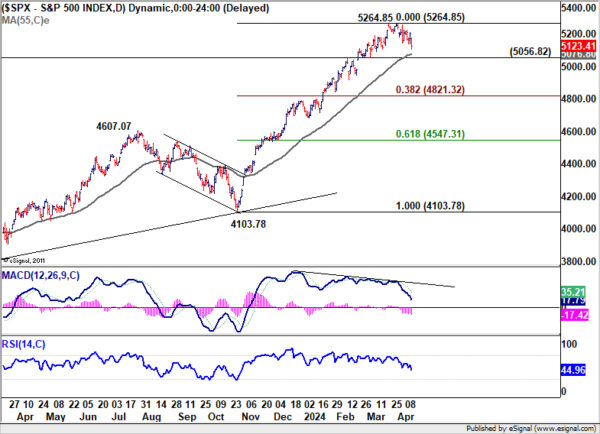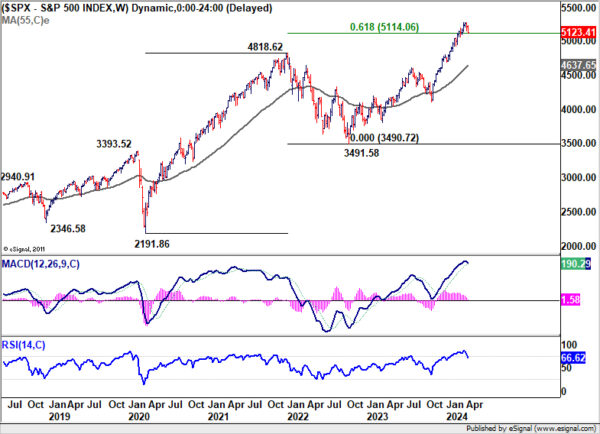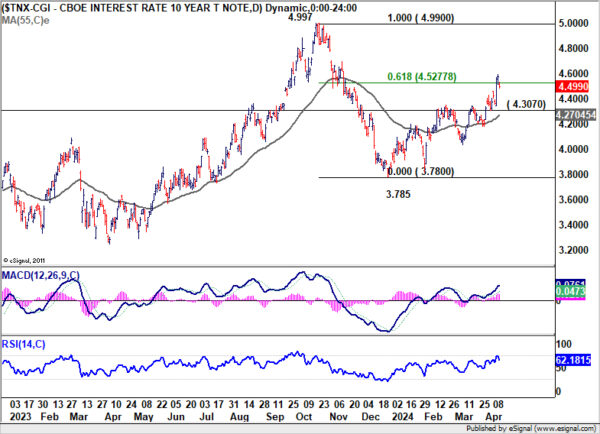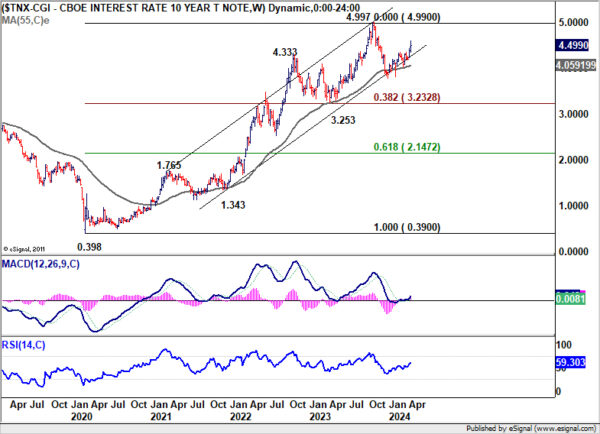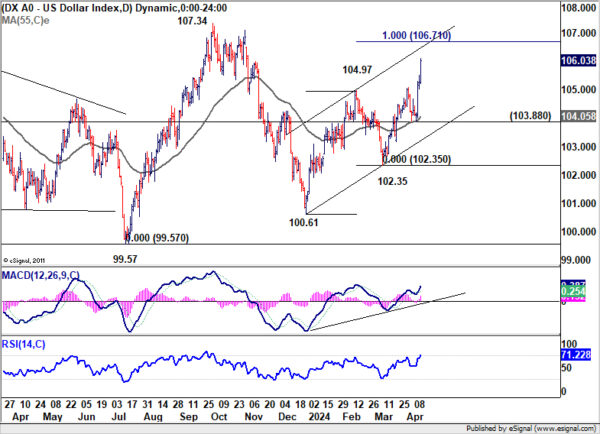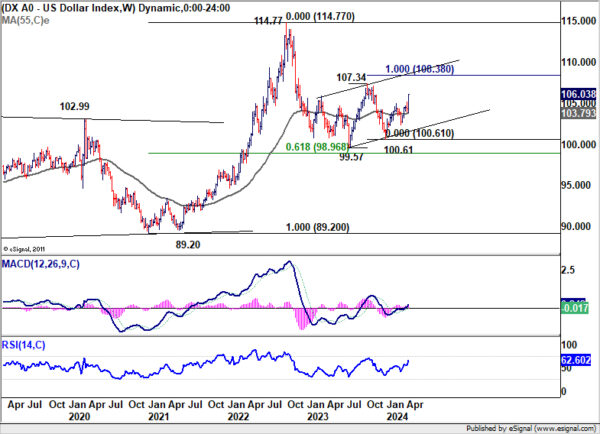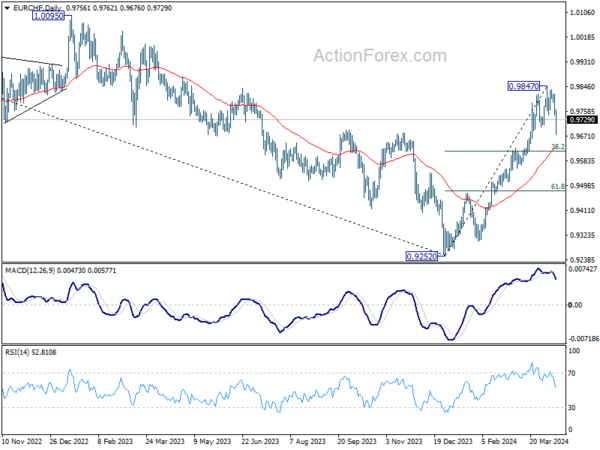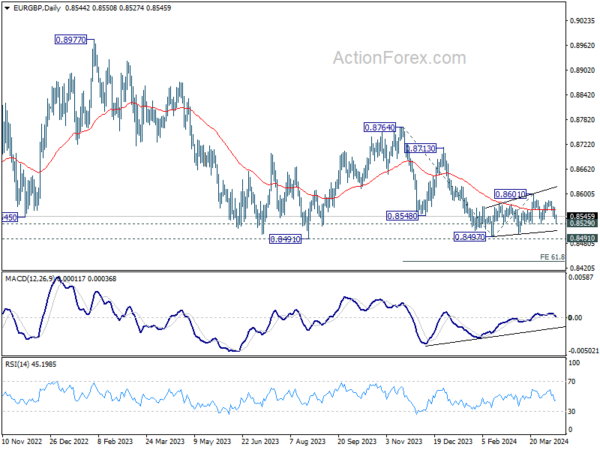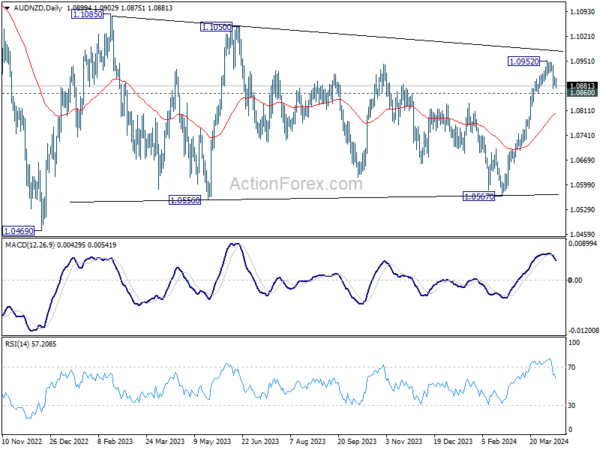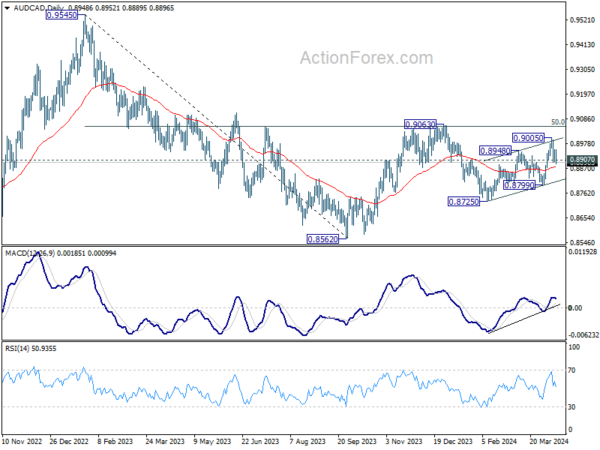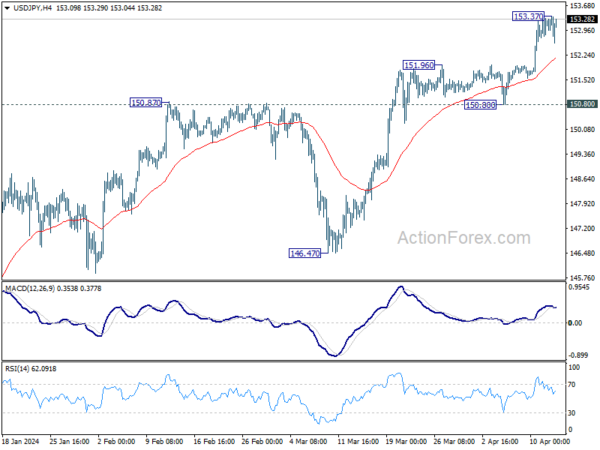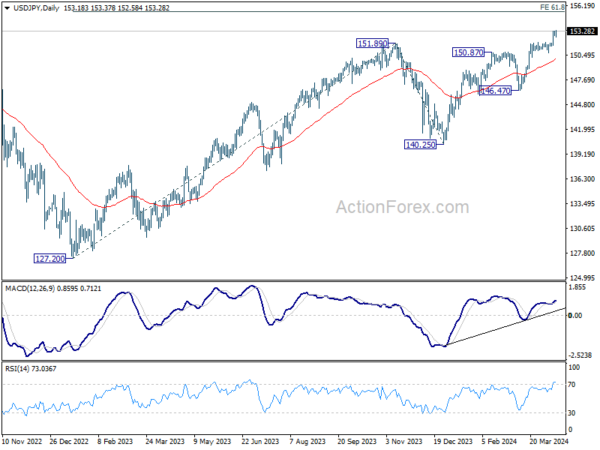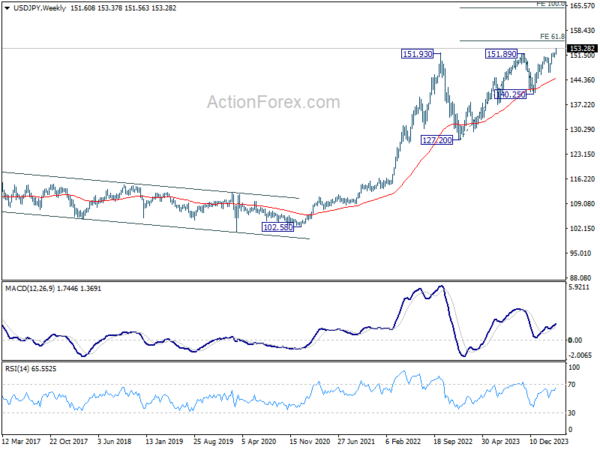[ad_1]
The monetary markets had been jolted final week by information confirming the stall in disinflation progress within the US. This improvement prompted merchants to rapidly revise their expectations concerning Fed’s financial coverage, withdrawing bets on a June charge discount. This shift in sentiment led to sturdy rise in treasury yields and corresponding deep decline in inventory markets, reflecting heightened investor warning and danger aversion.
Within the foreign money markets, Greenback was the first beneficiary of those shifts, because it capitalized on the confluence set bullish elements together with Fed charge expectations, rally in treasury yields, and a broad motion towards danger aversion. These elements collectively propelled Greenback to complete the week because the runaway winner.
There’s ample room for final week’s actions within the shares, bonds, and Greenback to proceed. Current bull runs in industrial metals and oil costs are possible the make the final mile of disinflation even tougher. Growing geopolitical tensions within the Center East is one other wild card that would additional sink market sentiments.
Within the broader foreign money markets, Euro ended the week because the weakest performer, because it encountered extra downward strain attributable to late selloff towards Swiss Franc and Sterling. The Australian Greenback additionally struggled, rating because the second weakest foreign money, dragged down by its underperformance towards different commodity-linked currencies.
Persistent Inflation Adjusts Fed Price Reduce Expectations, Shaking US Inventory Markets
The markets appeared to have deserted hope for a June charge minimize by Fed after stronger than anticipated March US CPI information. Core CPI unchanged from February’s studying at 3.8%. Extra importantly, it was down simply marginally from 4.1% six months in the past. The decline in core inflation has been very gradual, and clearly, the trail to 2% inflation just isn’t assured.
Fed fund futures now mirror a recalibrated outlook, with the likelihood of a charge minimize in September falling to 76.5%. The prospects for extra aggressive financial easing throughout the yr have additionally diminished, evidenced by solely a 62.8% probability of a cumulative 50 foundation factors minimize by yr’s finish. This extra conservative forecast means that whereas the market nonetheless largely anticipates one charge minimize from Fed in 2024, the opportunity of a second minimize is now seen with larger skepticism.
The market’s response to those adjusted expectations was stark, notably within the fairness sectors. Dow Jones Industrial Common bore the brunt of the downturn, plunging by -2.37% over the week. Equally, S&P 500 and NASDAQ declined -1.56% and -0.45%, respectively.
Technically, DOW’s fall from 39889.05 is now seen as a correction to the rally from 32327.20. Deeper fall ought to be seen to 38.2% retracement of 32327.20 to 39899.05 at 37000.42. Sturdy help is predicted there, at the very least on first try, to convey rebound. In the meantime, agency break of 55 D EMA (now at 38598.84) will argue that the vary of the corrective sample may have been set already.
Nevertheless, sturdy break of 37000.42 will put the second line of protection at 55 W EMA (now at 36144.65) in focus, and lift the prospect of a bigger correction to the up pattern from 28660.94, which is at present seen as a much less possible situation.
S&P 500 has been comparatively extra resilient, nevertheless it’s additionally beginning to look weak. Break of 5056.82 help and sustained buying and selling beneath 55 D EMA (now at 5076.80) will align the outlook with DOW, and make sure one another’s. On this case, deeper fall could be seen to 38.2% retracement of 4103.78 to 5264.85 at 4821.32.
Surge in 10-12 months Yield and Greenback Index
10-year yield surged sharply too to shut at 4.499 after reaching as excessive as 4.591. There isn’t any change within the outlook that rebound from 3.780 is the second leg of the corrective sample from 4.990 (2023 excessive). The stronger than anticipated rise mirrored the shift in market expectations for a much less aggressive Fed coverage easing cycle.
For now, the main target is on whether or not 10-year yield may maintain above 61.8% retracement of 4.997 to three.785 at 4.534. If it does, additional rally would then be seen to retest 4.997, which could possibly be in expectation that Fed may not minimize rates of interest this yr. In the meantime, break of 4.307 help will point out that 10-year yield has topped, at the very least for the close to time period.
Greenback index’s rally resumed after drawing help from 55 EMA and surged to shut at 106.03. Present rise from 100.61 is in progress for 100% projection of 100.61 to 104.97 from 102.35 at 106.71.
Value actions from 99.57 is at present seen as a corrective sample with rise from 100.61 because the third leg. Break of 107.34 resistance could possibly be seen. However upside would possible be capped by 100% projection of 99.57 to 107.34 from 100.61 at 108.38.
Euro Might Start to Falter Towards Sterling and Franc
Euro is beginning to seem weak towards its European counterparts, Swiss Franc and extra so Sterling, following ECB newest communications that hinted strongly at forthcoming charge minimize.
To be particular ECB articulated that, “If the Governing Council’s up to date evaluation of the inflation outlook, the dynamics of underlying inflation, and the power of financial coverage transmission had been to additional enhance its confidence that inflation is converging to the goal in a sustained method, it might be acceptable to cut back the present degree of financial coverage restriction.”
ECB President Christine Lagarde emphasised the importance of this new sentence within the put up assembly press convention, describing it as a “loud and clear indication” of ECB’s stance.
Whereas the SNB has already initiated charge minimize in March with one other presumably on horizon in June, its coverage charge at 1.50% presents associated restricted scope for additional reductions in comparison with ECB’s deposit charge at 4.00%. In the meantime, expectations for BoE have been adjusted, with market bets scaling again to 2 charge cuts this yr, beginning in September.
Technically, with final week’s steep pullback, EUR/CHF ought to have fashioned a brief time period high at 0.9847. Danger is mildly on the draw back within the close to time period for 38.2% retracement of 0.9252 to 0.9847 at 0.9620. However sturdy help is predicted from there to comprise draw back to convey rebound, and set the vary for sideway buying and selling.
EUR/CHF’s rally from 0.9252 could be able to resume as soon as readability is obtained concerning the terminal charges of ECB and SNB of their easing cycles, given the numerous rate of interest disparity that’s prone to persist. Bearish pattern reversal in EUR/CHF just isn’t anticipated until important geopolitical dangers materialize, prompting large safe-haven stream into Franc.
EUR/GBP would possibly now be on the verge of resuming its medium time period down pattern. Break of 0.8529 help ought to immediate deeper decline by 0.8491/7 help zone. Subsequent goal will likely be 61.8% projection of 0.8764 to 0.8497 from 0.8601 at 0.8436. The draw back breakout could possibly be catalyzed by incoming information indicating that BoE is on observe for under two charge cuts this yr, or fewer.
Kiwi Leads Amongst Commodity Currencies, Aussie Lags
New Zealand Greenback ended because the stronger one amongst commodity currencies, bolstered by RBNZ’s decisively hawkish stance. After leaving OCR unchanged at 5.50%, RBNZ expressed “restricted tolerance” for delay in bringing down inflation to focus on band. This clear dedication to combating inflation has bolstered expectations that RBNZ may not be prepared to chop rates of interest this yr but.
In the meantime, Canadian Greenback discovered some aid as BoC shunned dropping any express hints a few charge minimize in June, opposite to what some market contributors had anticipated. Australian Greenback, in the meantime, confirmed much less enthusiastic response to the prolonged rise in metallic costs. Regardless of Aussie’s current rally appears to have exhausted its momentum, with elevated dangers of a downturn towards its commodity foreign money counterparts.
Technically, AUD/NZD’s decline final week, with D MACD firmly crossed beneath sign line, signifies brief time period topping at 1.0952. Additional break of 1.0860 help ought to affirm rejection by medium time period falling pattern line resistance and goal 55 D EMA (now at 1.0803). Sustained buying and selling beneath this EMA will point out that the sideway sample from 1.1085 has already began one other falling leg again in direction of 1.0567 help.
AUD/CAD’s break of 0.8907 help argues that corrective rebound from 0.8725 may need accomplished with three waves as much as 0.9005. Sustained buying and selling beneath 55 D EMA (now at 0.8878) will solidify this bearish case. Deeper decline ought to then be seen by 0.8725 help to renew the autumn from 0.9063.
USD/JPY Weekly Outlook
USD/JPY’s up pattern resumed final week by breaking by 151.93 resistance. But it surely retreated after hitting 153.37. Preliminary bias is impartial this week for some consolidations first. Outlook will keep bullish so long as 150.80 help holds. Above 153.37 will goal 155.20 fibonacci projection degree subsequent.
Within the greater image, present rise from 140.25 is seen because the third leg of the up pattern from 127.20 (2023 low). Subsequent goal is 61.8% projection of 127.20 to 151.89 from 140.25 at 155.20. Outlook will now stay bullish so long as 146.47 help holds, even in case of deep pullback.
In the long run image, so long as 127.20 help holds (2023 low), up pattern from 75.56 (2011 low) continues to be in progress. Sustained buying and selling above 100% projection of 75.56 (2011 low) to 125.85 (2015 excessive) from 102.58 at 152.87 will pave the best way to 138.2% projection at 172.08. (This can be a pure technical view with out contemplating Japan’s intervention.)
[ad_2]




